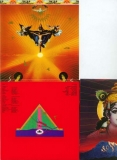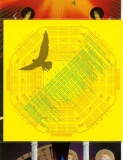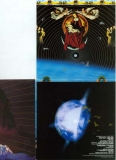|
|
||||||||||||||||||||||||||||||||||||||||||||||||||||||||||||||||||||||||||||||||||||||||||||||||||
Santana - Lotus (1974)One of the benefits of registering on this site is that you can add this to your private page and add notes then print details of your collection, want lists etc. You can also leave public comments on each release. Out of print (but other items from this artist may be available)
Click on an image to start viewing larger versions (min 1024 width recommended) Items with grey borders do not come with standard releases. They may be promotional items (eg. given away with a purchase from certain stores - such as Disk Union) or may be included here for comparison. They are not usually available when you buy this release from a store or on eBay unless specifically stated.
User Comments
There are no user comments yet for this release. Please log in to make a user comment. Login (or register) to leave comments. Release Details
Manufacturer: Sony
Mastering:Remastered
Channels:Stereo
Format:CD (3)
This version released:2006-06-07
Reprints:
Reprinted on or about: 2008-03-14 Reprinted on or about: 2010-09-22 Original LP release:1974.05
Genre:Rock
Packaging
Obi:
The back of the obi shows the complete Santana discography at the time Lotus was originally released (1974). Cover:
1.
On the right panel of the spread we find a lotus / buddha symbol superimposed on top of the photo - the same symbol as that found on the discs.
The centre panel (the panel what eventually becomes the centrepiece of the entire cover once opened in all its glory) shows a golden buddha. We can also see the back of the obi here. This shows all releases chronologically prior to this release including Buddy Miles and Mahavishnu John Mclaughlin - in other words the complete Carlos Santana discography (band and collaborations) when Lotus was released. 3.
Sri Krishna is seen on the other panel (to the right of the pyramid and the left of Buddha) with a peacock feather in his hair. There is a hand (Krishna's pressumably) emerging from the bottom of the image holding a lotus flower in full bloom (and of course a golden bird).
The top of the image is bordered with a repeating motif of a palm treed island and setting or rising sub. The inscription "Registered No.3097" can be seen under one of the suns. The next panel down details the track listing and credits for the third and final record / disc. This is on a bright red background. In the central part of this panel has a schematic of the interior tunnels and chambers of the Cheops pyramid. There is a flying saucer in the middle of the pyramid just below ground level. 5.
7.

8. Now we completely close and repack the left hand side. Having done this we are back with the simple open gatefold showing the audience. Alternatively, the whole section to the left of the tail of the plane can be pulled out and left to one side until the entire right hand side has been folded out. 9.
11.
13.
And finally...
The full cover opened up. Also shown here are the 3 CDs, 4 card inserts showing members of the band (across the top of the image), and the 3 CD inner sleeves. Editor Comments A poster of images from this album cover was made by CBS Sony Inc at the time. It appears in the book "100 Posters of Tadanori Yokoo" selected and with comments by Koichi Tanikawa. In 1974 Yokoo undertook to handle the design of a record album showing the twenty-two faces of rock star Carlos Santana, and for his work he received the Special Award at the 6th Graphic Art Biennale in Brno. This poster comprises the same images used in the album arranged on a single plane; a variety of sacred images both ancient and modern, oriental and occidental. With its images of Annunciation, the Virgin Mary, Mother and Child, Christ, angels, Krishna, Mahavairocana-tathagata, lotus blossoms, pyramids, the Sacred Triangle, UFOs and Himalayas, this poster could, without doubt, be described as a modern-day mandala, or graphic aid to meditation. Through the course of this work, Yokoo became extremely close friends with Santana. Santana revered the guru Sri Chinmoy and always recognised him as being one with God; therefore when he saw Yokoo's design it is probable that he immediately felt an empathy for the designer's mysticism, while Yokoo speaks of his first meeting with Santana as karma, or fate. Santana describes his feelings about this same meeting by saying: "I experienced most forcefully the impression that I had met Tadanori in a previous existence, and, moreover, I remembered that I myself had been Japanese in a previous existence." In speaking of Yokoo, Santana ordinarily refers to him "my spiritual disciple". The trademarks CBS and CBS International are used for the overseas equivalents of Columbia Records. In Japan, such albums are produced for Columbia by Sony. The poster measures 72.8cm by 103.0cm and appears in the book in black and white. It is not clear if it was originally in colour. CreditsArt Direction and Artwork by Tadanori Yokoo; Page credits and acknowledgments...
sam2095 - 2006-nov-23
2009-11-05 - Reprint (2008-03-14) recorded by robot harry (source CDJapan). 2010-10-22 - Reprint (2010-09-22) recorded by robot harry (source CDJapan). (Created : 2006 Aug 27 by System; Last mod: 2010 Oct 22 by sam2095)
(Modified 2007-Jan-8 by sam2095)
(Artist Oricon: 74252)
|
||||||||||||||||||||||||||||||||||||||||||||||||||||||||||||||||||||||||||||||||||||||||||||||||||
|
| ||||||||||||||||||||||||||||||||||||||||||||||||||||||||||||||||||||||||||||||||||||||||||||||||||
|
| ||||||||||||||||||||||||||||||||||||||||||||||||||||||||||||||||||||||||||||||||||||||||||||||||||
|
| ||||||||||||||||||||||||||||||||||||||||||||||||||||||||||||||||||||||||||||||||||||||||||||||||||






















 White obi (perhaps much the same as the original album's obi). The obi is wrapped around the middle of what appears to be a simple but thick triple gatefold cover.
White obi (perhaps much the same as the original album's obi). The obi is wrapped around the middle of what appears to be a simple but thick triple gatefold cover. Intially you fold open the cover to the left revealling a double spread of the concert
auditorium taken with a slightly fish eye lens from well above and behind the stage.
The band can be seen on the right of the photo.
A single spotlight crosses the auditorium picking out one member of the band.
Intially you fold open the cover to the left revealling a double spread of the concert
auditorium taken with a slightly fish eye lens from well above and behind the stage.
The band can be seen on the right of the photo.
A single spotlight crosses the auditorium picking out one member of the band.
 Opening left again we find the track list for the second record / disc along with credits. This is presented on top of a photo of the Egyptian "The Great Pyramid of Cheops" (Khufu) pyramid.
Opening left again we find the track list for the second record / disc along with credits. This is presented on top of a photo of the Egyptian "The Great Pyramid of Cheops" (Khufu) pyramid.











